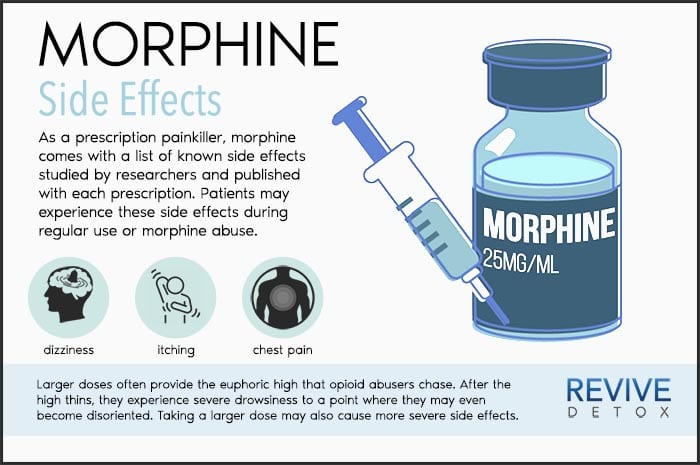Morphine is one of the oldest pain natural pain relievers, and modern morphine is the result of centuries of tinkering with the opium poppy.
As a pain reliever, it is both potent and abundant. Today, it’s common uses are for moderate to severe pain relief after a traumatic injury or surgery, or during cancer treatment or end-of-life hospice care.
Morphine comes with a high risk of addiction and abuse. Its pain relief properties are matched by the euphoria it also generates. Those suffering from morphine abuse may use it to deal with real physical pain, but they may take more than they need to chase the high it provides.
In some cases, people continue taking morphine even after they heal because the grasp it holds on them is so firm.
Are you concerned about someone you love who may deal with morphine abuse? Keep reading for a full guide to the improper use of morphine.
What Is Morphine Addiction?
Patients given prescriptions for morphine may take it without any problems. However, morphine abuse is prevalent because it offers a pleasurable high that’s hard to achieve with another drug.
Those who abuse morphine may take more than their prescription dosage permits. Others may take it even after their doctor rescinds their prescription or may lie about pain to continue receiving it.
The most abused morphine products are the tablets and patch. A common form of abuse is crushing the tablets into a fine powder for snorting. It is also possible to cut morphine patches to release the solution and inject it for a faster high.
Many people don’t realize they are addicted to morphine until their prescription runs out and they experience withdrawals. They might request a new order from their physician, but if denied, they might seek out a new physician or turn to a new drug like heroin.
Morphine has an extremely high street price because it is a pharmaceutical drug available by prescription only. The cost makes it unaffordable for many.
What Are the Risk Factors for Morphine Addiction?
Why are some people able to leave morphine behind while others become addicted? A risk-focused approach to drug abuse helps us understand what happens to allow and encourage abuse.
Studies show that opioid abuse and misuse (including morphine) occurs most commonly in the following categories:
- age 18-34
- male
- four or more opiate or opioid prescriptions
- early prescription refills
- prescriptions from two or more pharmacies
- prescriptions from two or more physicians
Other issues that predict risk for opioid abuse include the above categories plus:
- nonopioid substance abuse
- posttraumatic stress disorder
- hepatitis
- depression
Contextual factors play a significant role. In the case of morphine, the over-prescription of opioids allowed more people to take larger doses of morphine over more extended periods and even offered scripts to those who would have been better served by a less potent drug.
Allowing people to take more of such a potent drug helped foster abuse and addiction in people who might not have otherwise encountered it.
Physiological factors also play a role. Researchers have found that sensation seeking predicts abuse of drugs and alcohol. Sensation seeking may have links with MAO activity.
Studies also show that stress can lead to abuse, particularly in vulnerable individuals. Stress may impact both increasing drug use and relapses experienced over time. However, it is important to note that some of the evidence is correlational, and the impact of stress is still under assessment.
Symptoms and Morphine Side Effects
The symptoms of morphine abuse are similar to the signs of opioid abuse generally. They may run out of their prescription dosage faster. You may also notice that they visit different doctors or pharmacies and go out of their way to visit businesses that aren’t in your locale. Additionally, they may become very irritable when they miss a dose, even after several weeks or months of healing.
Someone abusing morphine is also likely to isolate themselves and continue to use the drug despite negative consequences. They may also take place in risky behaviors like driving under the influence and seeking ways to buy morphine outside a pharmacy.
A tell-tale sign is the onset of withdrawal symptoms when the drug is inaccessible.

- Anxiety
- Constipation
- Dizziness
- Drowsiness
- Itching
- Nausea
- Vomiting
Larger doses often provide the euphoric high that opioid abusers chase. After the high thins, they experience severe drowsiness to a point where they may even become disoriented.
Taking a larger dose may also cause more severe side effects including:
- Chest pain
- Slowed heart rate
- Slowed respiration
- Weakness
- Severe dizziness
You may also be more likely to experience severe side effects if you are elderly or you have underlying health issues.
It is possible to overdose on morphine. The signs of a morphine overdose include:
- Sweating
- Headaches
- Vomiting
- Hallucinations
- Clammy skin
- Severe drowsiness
- Lack of responsiveness
- Unconsciousness
- Pale complexion with blue lips and fingernails
- Breathing complications
If you see these side effects in a person you know to have a morphine prescription, seek medical help immediately.
Morphine Treatment and Recovery
Treating morphine addiction is possible
Finishing a morphine detox in seven to ten days is possible. However, many people find the hardest part of getting clean is staying clean.
In addition to talk therapy, patients addicted to morphine and other opioids may take a medicate maintenance program with methadone to help stave off cravings.
Medicated treatment programs show far higher rates of long-term success compared to treatment without medication replacements.
Seek Help Today
A morphine prescription may start as a medical necessity, but the drug grabs hold of even the most resilient patients, resulting in morphine abuse and addiction. Some people may not even realize they have a problem until their prescription runs out and it’s too late.
If you or someone you love is struggling to manage their use of morphine or another pain pill, know that help is available. Click here to learn more about detox and addiction treatment.Most PPO Health
